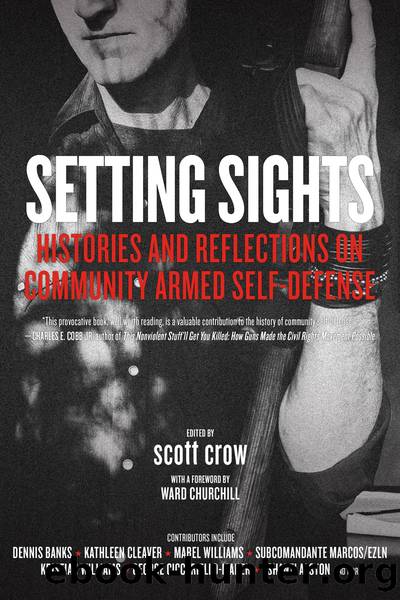Setting Sights by Scott Crow

Author:Scott Crow
Language: eng
Format: epub
Publisher: PM Press
Published: 2018-07-15T00:00:00+00:00
Notes
This is an excerpted, edited, and annotated version of a talk presented by these three women in Oakland in 2004. See the full version from FreedomArchives.org /AK Press.org at http://vimeo.com/87520418, accessed June 27, 2017.
Repression Breeds Resistance: The Black Liberation Army and the Radical Legacy of the Black Panther Party
Akinyele Omowale Umoja
Introduction
The Black Panther Party (BPP) was one of the most significant radical movements in American history. As an organized political organization, the BPP existed from 1966 to 1982. Many activists and scholars argue that the BPP only existed as a revolutionary organization from 1966 until 1971, in the initial period of its existence. In this period, the BPP emphasized armed resistance as a primary means of achieving social change. After 1971, historians of the BPP argue the organization dropped its revolutionary, pro–armed resistance agenda to pursue reformist politics.1 While governmental repression led to the ascendancy of a reformist agenda for one faction of the BPP, it was not the only organizational response. Some BPP members committed themselves to involvement in or support of clandestine military resistance that accelerated the development of the armed movement called the Black Liberation Army (BLA).
“The Black Liberation Army,” Assata Shakur informs us, “was not a centralized, organized group with a common leadership and chain of command. Instead there were various organizations and collectives working together out of various cities, and in some larger cities there were often several groups working independently of each other.”2
Given this multiple and decentralized character it is unsurprising that there are different accounts of its origins and composition. Some scholars see the BLA as a result of the split within the Panthers.3 However, former political prisoner and Black revolutionary Geronimo ji-Jaga suggests that several Black revolutionary organizations contributed to the ranks of a Black underground that was collectively known as the Black Liberation Army.4 Since the BPP was the largest revolutionary nationalist organization of the Black liberation movement of the 1960s and ’70s, its membership contributed greatly to the BLA’s numbers. The nature of that relationship—especially the influence and participation of BPP members and supporters in the Black Liberation Army—constitutes the focus of this study.5
Download
This site does not store any files on its server. We only index and link to content provided by other sites. Please contact the content providers to delete copyright contents if any and email us, we'll remove relevant links or contents immediately.
| Africa | Americas |
| Arctic & Antarctica | Asia |
| Australia & Oceania | Europe |
| Middle East | Russia |
| United States | World |
| Ancient Civilizations | Military |
| Historical Study & Educational Resources |
Cecilia; Or, Memoirs of an Heiress — Volume 1 by Fanny Burney(32495)
Cecilia; Or, Memoirs of an Heiress — Volume 2 by Fanny Burney(31909)
Cecilia; Or, Memoirs of an Heiress — Volume 3 by Fanny Burney(31889)
The Secret History by Donna Tartt(18943)
Sapiens: A Brief History of Humankind by Yuval Noah Harari(14315)
Leonardo da Vinci by Walter Isaacson(13233)
The Radium Girls by Kate Moore(11970)
Sapiens by Yuval Noah Harari(5321)
How Democracies Die by Steven Levitsky & Daniel Ziblatt(5170)
The Wind in My Hair by Masih Alinejad(5056)
Homo Deus: A Brief History of Tomorrow by Yuval Noah Harari(4871)
Endurance: Shackleton's Incredible Voyage by Alfred Lansing(4718)
Man's Search for Meaning by Viktor Frankl(4502)
The Silk Roads by Peter Frankopan(4488)
Millionaire: The Philanderer, Gambler, and Duelist Who Invented Modern Finance by Janet Gleeson(4418)
The Rape of Nanking by Iris Chang(4165)
Joan of Arc by Mary Gordon(4053)
The Motorcycle Diaries by Ernesto Che Guevara(4050)
Hitler in Los Angeles by Steven J. Ross(3923)
